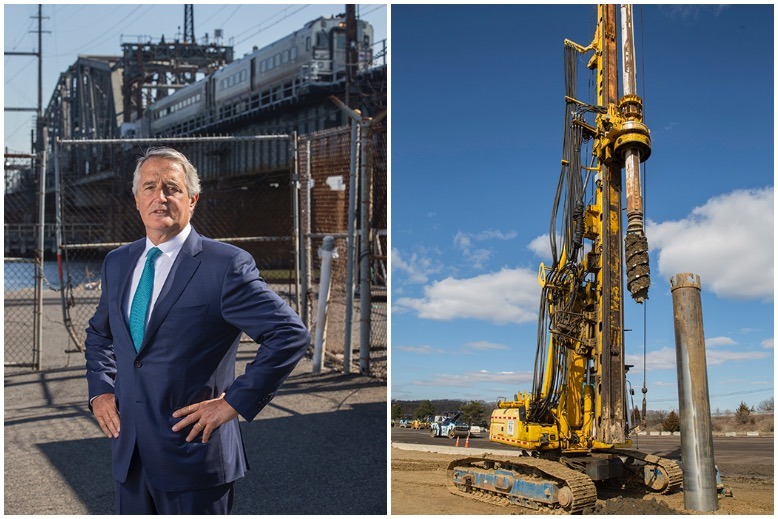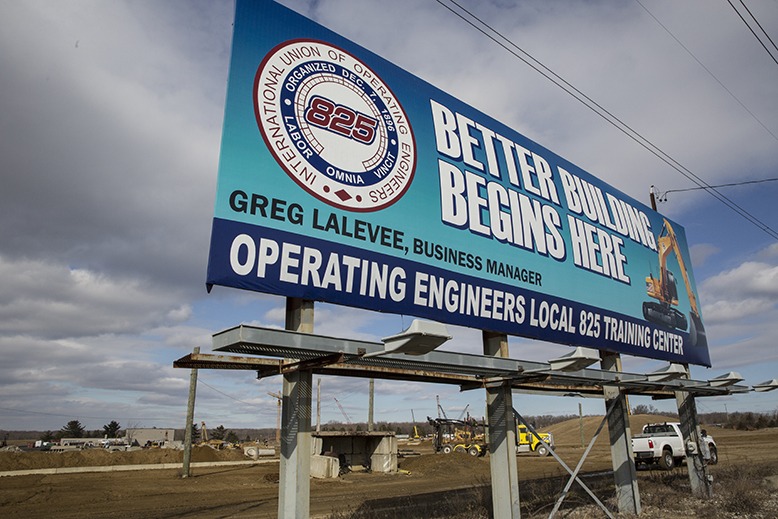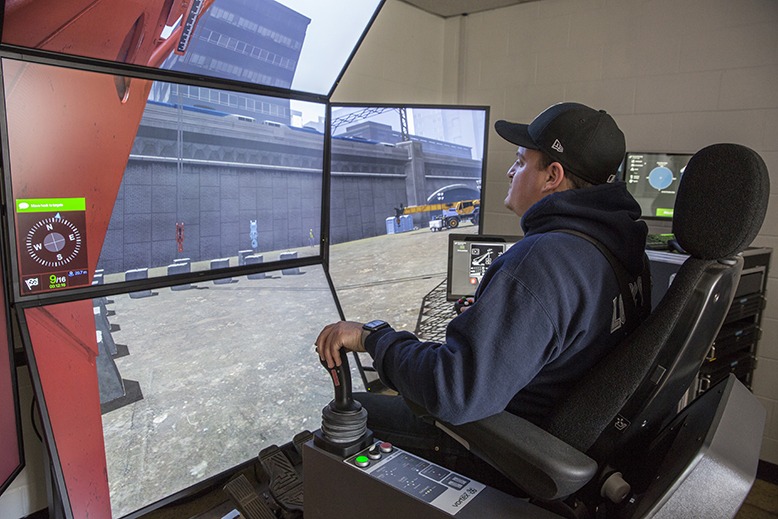
Left: Jerry Zaro, the New Jersey trustee of the Gateway Program Development Corp., at the Portal Bridge, alongside the Hackensack River. A government agency recently cleared the way for federal funding to replace the bridge. Right: This giant Bauer Drill is used to bore holes for pilings and other construction needs. Members of Local 825 are training on this drill and other machinery in anticipation of the Gateway Tunnel project. Photos by Fred R. Conrad
Next door to a Taco Bell in North Bergen, along the west-facing wall of the Palisades, is a wide and forlorn vacant lot girded by a chain-link fence. Weeds poke through the concrete and asphalt. It looks like an abandoned site for yet another of the gas stations that line this busy stretch of Tonnelle Avenue, but it is in fact the place where one of New Jersey’s grandest dreams has met its biggest obstacle.
Every few minutes, the sound of a whistle drifts up from the Northeast Corridor tracks below as a New York–bound train snakes through the marshes toward the rail tunnel that cuts into the hillside just a few hundred feet north. The tunnel is 109 years old, and—in the opinions of most of the 200,000 riders who travel through it each day, as well as nearly everyone else who contemplates its impact on the metropolitan-area economy—should have been replaced long ago.
Many riders have heard about the plans for a new tunnel through the Palisades and under the Hudson River into Manhattan. That new tunnel is set to be right here—next to the Taco Bell—once all this earth is dug out and a new portal is opened. For now, there is just a graffiti-covered retaining wall.
“This tunnel, as sure as I am standing here, is getting built,” says Jerry Zaro as he steps through a gap in the fence. Zaro is the New Jersey trustee of the Gateway Program Development Corporation, which was formed in 2016 as the latest incarnation of the long-running effort to upgrade the critical but vulnerable rail connection between New Jersey and New York. “Now the only question is, are we going to do it properly with preventative money, or are we going to do it with disaster-relief money?”
The obstacle is not physical. The Pennsylvania Railroad tunneled this route way back during the Taft administration, and the plans have long been drawn to do it again. Local 825 of the International Union of Operating Engineers has apprentices working now on a rail-rehabilitation project in Somerset County, learning the kinds of specialized skills the union hasn’t had much call for in recent decades. Other union members, using a boring machine more than 400 feet long, are currently digging another tunnel under the Hudson—the Delaware Aqueduct Bypass in Newburgh, New York—which will carry water to New York City.
“We’re trying to get as many younger people exposed to this kind of work as we can,” says Greg Lalevee, business manager of the 7,500-member local, which anticipates that hundreds of its members will be needed.
The obstacle is financial. Big infrastructure projects like the tunnel, with its estimated $11.1 billion price tag, require big investments of money and political will. Both have ebbed and flowed in recent years. Crews were digging under Tonnelle Avenue until Governor Chris Christie canceled the earlier ARC tunnel project in 2010. The damage to the two tubes of the existing tunnel from Hurricane Sandy in 2012 underlined the need for a new one, and plans were resurrected as part of the broader Gateway Program, a proposed series of ambitious construction projects to upgrade the 10-mile stretch between Newark and Manhattan, where so many commuters have spent so many despairing hours gazing out over the marshes during train delays.
One of those projects is inching closer to actual shovels in the ground: a $1.6 billion replacement for the Portal Bridge, the rail bridge over the Hackensack River in Kearny and Secaucus that, each time it pivots open, has about a one-in-seven chance of not closing properly, delaying some of the 450 Amtrak and NJ Transit trains that cross it each day. But the planned tunnel remains an empty, windswept lot, and the fond wish both of rail riders and the construction workers waiting to build it.
“Our biggest problem is, ‘Out of sight, out of mind,’” says Zaro as he walks across the lot, talking about the saltwater that has eaten away at the existing tunnel and the havoc that its closure would cause. The new tunnel was nearing approval under the Obama administration, but has stalled under Donald Trump. “If you could pull our existing tunnel out and string it across the Hudson just like the George Washington Bridge,” says Zaro, “the outcry would be so deafening that the pressure would result in an approval immediately.”
[Update: In late April, Trump and Congressional leaders agreed on a $2 trillion infrastructure plan, although without an agreement on how to pay for the program. In an Oval Office interview that followed, Trump indicated Gateway would be one of the priorities.]
* * *

Local 825 members upgrade their skills at a 61-acre training site in Dayton, along the southbound side of the New Jersey Turnpike. Photo by Fred R. Conrad
Along the southbound side of the New Jersey Turnpike in Dayton, behind a billboard that declares, “Better Building Begins Here,” beneath a crane holding an American flag is another wide and empty lot that looks more like an active construction site. Bulldozers, excavators and other pieces of heavy equipment have worked this dirt for decades, but nothing has ever been built here–except the skills to build things in other places.
Operating engineers run the machines that pave roads, build bridges, lay pipelines, lift steel into the skeletons of tall buildings, and steer big construction jobs of all kinds. This 61-acre training center is where they learn their skills. Apprentices start here, mastering their first machines; veterans come back to learn new ones. It is busiest in the cold months, when construction slows and 80 or more members arrive daily at the Dayton site to practice on the machines out on the lot, then head inside to absorb lessons in the classrooms. The training program is structured enough that Local 825 hopes to be accredited soon to offer an associate degree in technical studies.
“This dirt has been beaten to hell for 60 years,” says Lalevee as he drives a pickup truck through the site, watching bulldozers level hills, excavators dig trenches, and side booms lift pipes.
“It’s like two o’clock in the afternoon,” adds Willie Vaccaro, the training director who is riding with him, “and I’m looking out here, and there are piles of stuff everywhere, and then by 3:30, everything looks like a pool table. I don’t know how they did it, but they did it.”

Crane operator Kolby Mitchell maneuvers a weight through a maze of poles topped with tennis balls. Operators earn points toward crane certification by successfully navigating the weight through the maze. Photo by Fred R. Conrad
Local 825 has been for both of them, as it has for many other members, a family tradition. Lalevee’s father was a member, as are two brothers, and when he stopped at a trailer in the paving section of the lot during the lunch break, he ran into a cousin. Vaccaro is a third-generation member. The apprentice coordinator, Shana Grace-Rogers, is fourth generation; as a girl, she watched her father run a tower crane as the Golden Nugget casino was rising in Atlantic City.
“He wanted me to finish college, but I went behind his back and came up here and got an application for the apprenticeship,” says Grace-Rogers. “I did site work, dirt work, a little bit of everything.”
Successful applications are coveted tickets into a union where the hourly pay starts at $44 and rises to $50–even more for the most skilled operators on the most difficult machines. Local 825 distributes only 250 applications once every two years. (It distributes 60 of them in the intervening years for its smaller unit in Rockland County, New York.) The line starts forming around noon on the Friday before Labor Day, the door opens at 7 am on the Tuesday after, and the applications are usually gone by noon. About 30 applicants are chosen for the apprentice program.
Brad Miller was serving in the Coast Guard when he joined that line in 2016. He is now in his fourth and final year as an apprentice—the first in his family in Local 825. On this day, Miller—just back from reserve duty and sitting in the cab of a crane with a tall boom—deftly guides the large red weight that dangles from it through a zigzag course of slender white poles topped with yellow tennis balls. Nudge a pole hard enough to dislodge a tennis ball: points off. Knock over a pole: more points off. Fail to land it in a target circle at the end: still more points off.
Miller gets the weight through as cleanly as if he were carrying it in his own hands.
“I started on dozers and excavators, a lot of dirt work,” he says later, in the classroom building. “It’s important to be well-rounded as an operator.”

Operator John Angelli at the controls of a crane simulator, which recreates difficult weather conditions. This tests the operator’s ability to control the crane in wind or rain, for example. Photo by Fred R. Conrad
Some apprentices and instructors are clustered around a crane simulator, testing their skill as it throws wind, rain and snow on the big screen, making their boom as whippy as a fishing pole. The talk turns, as it often does, to some of the big jobs of recent years: the replacement of the Tappan Zee Bridge; the raising of the Bayonne Bridge; the widening of the Turnpike and the Parkway. But the biggest topic is the one whose fortunes they monitor and speculate upon as intently as daily rail commuters do.
“That’s good news on the Portal Bridge,” says Miller to Lalevee.
“We hope,” Lalevee replies.
* * *
In the middle of the wide and empty marshes, at the edge of the Hackensack River, Zaro stands beside the Portal Bridge. A train rumbles over it, bound for New York. “They have loosened the purse strings for this, and now it will be able to go forward,” he says, referring to the recent decision by the Federal Transit Administration to upgrade the eligibility of this phase of the Gateway Program for federal funding.
The new bridge will be a long, fixed span, high enough for tugboats to pass under. For its foundations, crane operators like Miller will drive piles near the spot where Zaro stands. “But what good is it without the tunnel?” Zaro adds. “You’re going to now speed people to the bottleneck much faster.”
The tunnel itself is still not eligible for federal funding, and Gateway advocates were further alarmed recently when U.S. Transportation Secretary Elaine Chao suggested a plan they regard as impractical: to rehabilitate the existing tubes while still in service, before a new tunnel is built.
Zaro sees a political subtext to the Trump administration’s lack of support for the project. “President Obama saw this,” Zaro says about the need for a new tunnel. “President Trump, by the way, saw this, too—for the first two months, until he decided to pick a fight with [New York senator] Chuck Schumer.”
Nat Bottigheimer, New Jersey director for the Regional Plan Association, echoes Zaro’s sentiment. “We expect that the [Trump] administration will seize on any talking point that emerges that allows them to distract from the main points, which are that we need new capacity and we need redundant capacity,” Bottigheimer says. “This really is a constituency of one, and that is the president. It is the president who is the obstacle, and we can lobby his minions as much as we want, but he’s calling the shots.”
(At a March 31 press conference about the coronavirus, Trump hinted he might ease the brakes his administration has placed on the tunnel project. In discussing a possible $2 trillion infrastructure bill, he said, “We fix up our tunnels, which are many of them in bad shape, like coming into New York, as you know, really bad shape.”)
If one of the two tubes in the existing tunnel fails, the other tube will have to carry every train both in and out, and capacity will drop by 75 percent. People and goods will have to find other ways to cross the river in a transportation network that won’t be able to handle them all. The effects would ripple across the economy: real estate values could drop, jobs could vanish, people might move. New Jersey could grow more isolated from the economic engine of New York.
“This is an incredibly high-value state to live in, and you’ve got to invest in that,” Bottigheimer says. “This is an issue not just for the people who are riding the rails, who would have trouble getting into New York. It’s really an existential issue for everyone in New Jersey.”
